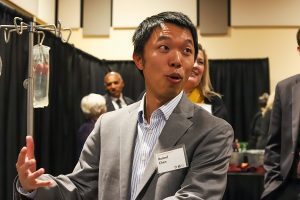Local hospital hopes to install residency program
Pullman Regional holds seventh annual Health Innovation Summit, plans for residency program
ROLAND HUIE | THE DAILY EVERGREEN
Erika Fleck, Director of Education and Information Technology at WSU Spokane, talks about virtual reality and the effects this technology has with medical students on Tuesday evening at the 2019 Health Innovation Summit at the SEL Event Center.
September 18, 2019
Pullman Regional Hospital is pursuing a residency program to help train postgraduate medical students.
The hospital held its 2019 Health Innovation Summit at 5:30 p.m. Tuesday to inform community members about the residency program and other areas the hospital and its partners have been working in.
“I want people to understand what the residency is, why it’s important, how it benefits them directly and also the community in general and why it’s worth investing time and money into,” said Scott Adams, Pullman Regional Hospital CEO.
Most residency programs require additional financial support, he said, so they wanted to use the summit to generate enthusiasm for the program.
Jonathan Espenschied, associate dean of graduate medical education, said residency programs are primarily about education for the residents, but they also work alongside doctors to provide medical care.
“You do four years at medical school, you graduate, you have a medical degree, but you can’t practice medicine until you finish your residency,” he said.
They hope to be able to host 12 residents total when the program is up and running. They want the program to consist of four new residents a year for a three-year program, Espenschied said.
Adams said the first step to getting a residency program is having it accredited.

Roland Chen, faculty member at WSU’s School of Mechanical and Materials Engineering, speaks about mechanical simulations that benefits medical students at the 2019 Health Innovation Summit at the SEL Event Center.
They cannot have a residency program until it meets the standards set by the accreditation council for graduate medical education, he said.
“We’re just in the design and development phases now and we have to see what we have as far as requirements go, what the patient mix looks like to decide what our curriculum and didactics are going to be,” Espenschied said.
The summit also included displays of what the hospital and the medical school have been developing.
There were several different stations set up around the meeting room where the new innovative medical projects were being displayed.
One of those was a virtual reality simulation of the human body.
Erika Fleck, Elson S. Floyd School of Medicine director of education and information technology, said they use VR as a supplement to the curriculum for anatomy.
Students can use the technology for educational purposes, she said. The technology has been used for post-test VR archery contests for stress relief.
They also use the technology in scholarly projects, she said, which all medical students are required to engage in.
One student partnered with Providence Sacred Heart Medical Center and Children’s Hospital in Spokane, and made a virtual reality video of what it is like to be a pediatric patient prepping for a procedure, she said.
“When pediatric patients come to Sacred Heart they can put on that headset and have an immersive virtual reality experience to get ready and we hope that will reduce anxiety,” Fleck said.
Another station displayed wearable simulation technology.
Roland Chen, assistant professor in the School of Mechanical and Materials Engineering, said wearable simulation technology is artificial human tissue that a person can wear that allows students to practice giving shots or bandaging.
If you just practice on a dummy it takes much of the realism out of the experience, he said. Even if it is artificial flesh the needle is going into, having it on a human makes it a much more lifelike experience.






















